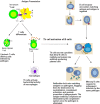An introduction to immunology and immunopathology
- PMID: 30263032
- PMCID: PMC6156898
- DOI: 10.1186/s13223-018-0278-1
An introduction to immunology and immunopathology
Abstract
Beyond structural and chemical barriers to pathogens, the immune system has two fundamental lines of defense: innate immunity and adaptive immunity. Innate immunity is the first immunological mechanism for fighting against an intruding pathogen. It is a rapid immune response, initiated within minutes or hours after aggression, that has no immunologic memory. Adaptive immunity, on the other hand, is antigen-dependent and antigen-specific; it has the capacity for memory, which enables the host to mount a more rapid and efficient immune response upon subsequent exposure to the antigen. There is a great deal of synergy between the adaptive immune system and its innate counterpart, and defects in either system can provoke illness or disease, such as inappropriate inflammation, autoimmune diseases, immunodeficiency disorders and hypersensitivity reactions. This article provides a practical overview of innate and adaptive immunity, and describes how these host defense mechanisms are involved in both heath and illness.
Figures


References
-
- Murphy KM, Travers P, Walport M. Janeway’s immunobiology. 7. New York: Garland Science; 2007.
Publication types
LinkOut - more resources
Full Text Sources
Other Literature Sources
Medical

